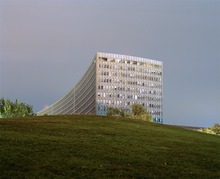Alberto Camenzind
Alberto Camenzind (born June 7, 1914 in Lugano ; † September 29, 2004 in Astano ) was a Swiss architect and professor at the ETH Zurich . He gained fame as the chief architect of the Swiss national exhibition Landi 64 ( Expo 64 ).
Life
Camenzind studied architecture at the ETH Zurich from 1933 to 1939, as did Max Frisch and Justus Dahinden at the time with William Dunkel . After graduating, he worked in the offices of Otto Rudolf Salvisberg and William Dunkel. In 1942 he opened his own studio in Lugano. As a first public contract, Camenzind built the grammar school in Bellinzona in 1958, the studio of Radio della Svizzera Italiana in Lugano in 1961 and the headquarters of Alfa Romeo in Agno in 1963 .
He became internationally known as co-director of Expo 64 in Lausanne, for which he designed a thematic program with “multi-cell exhibition centers” as chief architect. The implemented “Swiss Path” as a leitmotif of the Expo received particular attention.
1965 Camenzind received a call for a professorship at ETH Zurich appointed. In 1981 he retired.
In 1973 he realized the “Center International de Conference” and in 1975 together with Pier Luigi Nervi the “Bureau International du Travail (BIT)”. At its time, the BIT was the largest office building in Switzerland with a 200 meter long and 50 meter high skyscraper.
He documented his Ticino origins in 1963 with Haus Gmür in Brissago and in 1984 with Quartier Maghetti in Lugano, where he skillfully staged exposed concrete and quarry stone masonry.
In 1964 Alberto Camenzind became an honorary citizen of Lugano. He was a member of the Federal and Ticino Monument Preservation Commissions and from 1965 to 1972 a member of the Federal Art Commission .
buildings
- 1958 Bellinzona grammar school
- 1961 Studio of the Radio svizzera di lingua italiana in Lugano
- 1963 Building for Alfa Romeo in Agno
- 1963 Gmür House, Brissago
- 1972 Cantonal School Lugano, together with Bruno Brocchi and Roberto Sennhauser
- 1973 Center International de Conference in Geneva
- 1975 Bureau International du Travail, headquarters of the International Labor Organization in Geneva
literature
- Marino Cattaneo: Alberto Camenzind. In: Historical Lexicon of Switzerland . June 14, 2012 , accessed December 13, 2019 .
- TF Meyer and others: Chair of Prof. Alberto Camenzind 1973-81. ETH, Zurich 1982.
- Werner Oechslin , Flora Ruchat-Roncati (Ed.): Alberto Camenzind 1914-2004. Architect, chief architect Expo 64, teacher. gta Verlag, Zurich 1998, ISBN 978-3-85676-078-6 .
Web links
- Literature by and about Alberto Camenzind in the catalog of the German National Library
- Alberto Camenzind. In: arch INFORM .
- "Exhibition Alberto Camenzind" (ETH Zurich) ( Memento from October 31, 2004 in the Internet Archive )
| personal data | |
|---|---|
| SURNAME | Camenzind, Alberto |
| BRIEF DESCRIPTION | Swiss architect and professor at the ETH Zurich |
| DATE OF BIRTH | June 7, 1914 |
| PLACE OF BIRTH | Lugano |
| DATE OF DEATH | September 29, 2004 |
| Place of death | Astano |
